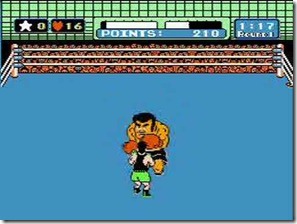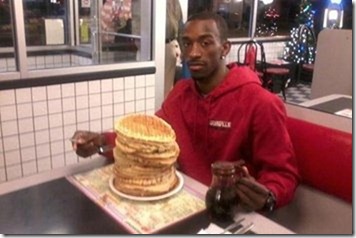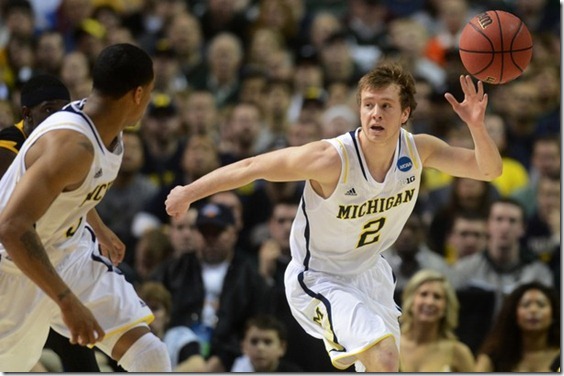JINX FEARERS: Look man if Michigan makes the national title game I don't want to have to write a preview that I can have done beforehand, because then I can write about the game they just played. This does not assume victory over Syracuse.
YES I AM DOING WICHITA GAWD
![louisville-hotlinemiami louisville-hotlinemiami]() THE HYPOTHETICAL ESSENTIALS
THE HYPOTHETICAL ESSENTIALS
| WHAT | Hypothetically? Michigan vs Louisville Hypothetically. |
|---|---|
| WHERE | Georgia Dome Atlanta, Georgia |
| WHEN | TBA (srs), Monday |
| LINE | I DON'T KNOW PANIC |
| TV | CBS |
If you're having Hotline Miami flashbacks, you are not alone. [Via Card Chronicle.]
THE HYPOTHETICAL TEMPO-FREE
Four factors. Ranks are in parentheses and out of 347.
| eFG% | Turnover % | Off. Reb. % | FTA/FGA | |
|---|---|---|---|---|
| Offense | 50.4 (94) | 18.5 (90) | 38.2 (16) | 39.6 (77) |
| Defense | 44.4 (24) | 27.5 (2) | 33.2 (236) | 34.3 (131) |
Okay, so. Remember Piston Honda? VCU is Minor Circuit Piston Honda. Louisville is World Circuit Piston Honda.


left: VCU. Right: Louisville.
On defense Louisville is VCU… with Jeff Withey at center. As a team, anyway. While Gorgui Dieng isn't quite in Withey's stratosphere as a shotblocker, UL's defensive numbers are basically VCU plus near-elite eFG% defense and fewer free throws ceded. That latter isn't likely to be relevant against FT-averse Michigan, which acquired just 11 attempts against the Rams. The former most certainly is.
The VCU comparison holds on offense, as well. The Cardinals have a decent eFG% offense propped up by defense-created fast breaks. (The next section attempts to quantify how much that ballhawking defense impacts their offense.) They're okay at turnovers. They crash the boards like whoah. They struggle behind the line, so they don't shoot many threes. The main difference is free throws, which VCU was poor at acquiring; UL is good at it mostly thanks to Russ Smith.
THE VCU THING

I SMELL YOUR FEAR
Michigan gets about 8% of their shots off of steal-generated fast breaks, which they convert at a lovely 71% eFG. Based on my ballparking of the various teams I've hoop-mathed this year, that's a pretty standard quantity. VCU was exceptional because they got 50% more of their shots in that extremely profitable situation.
Louisville is like that, only moreso: 14% of their shots are steal-generated fast breaks, a 75% bonus. What's more, VCU was a good bit less efficient than Michigan in those situations (63%). Louisville is at 68%.
If you've watched them in the tournament, you have felt this. Louisville doesn't look like anything too amazing until a three minute stretch in which Smith and Siva are going YOINK YOINK YOINK YOINK and the next time you look up Louisville is up 15 and the game is over. Duke and Syracuse, to name two teams kind of good at basketball, are all like "WHA HAPPEN" after Louisville transformed competitive games into laughers in the second half.
Meanwhile, Louisville does not run that much off misses, or at all effectively. The transition gap goes the other way: Michigan gets 19% of their shots in transition off misses, Louisville 14%. What's more, UL is hardly better than their halfcourt offense in that situation (52% versus around 45%). Michigan is at a crushing 65%.
Stage one of taking down the end boss is crippling their fast break points, bringing their iffy shooting into focus and fueling their own transition game. Michigan is better-prepared than any team in the country to do this.
THE HYPOTHETICAL THEM
Soon-to-be Kenpom Player of the Year Russ Smith shoulders a huge proportion of the UL offense—almost a third of UL shots are his. Here is a pile of waffles that represents Smith's importance to Louisville.

THAT'S A LOT OF WAFFLES I TELLYA
His efficiency is only decent, but given his sheer volume that's still impressive. His main asset is a ton of FTAs he hits at 82%. Shots from the floor are only eh—he hits 47/33. He converts at exactly the same rate 'Cuse's Michael Carter-Williams does on two point jumpers: 30%.
Smith's efficiency is dependent on going to the rim, and going to the rim, and going to the rim. Largely in transition. As of 22 games into the season, Smith was averaging 7.5(!!!) transition possessions per game, which is second only to Jimmer Fredette over the last four years:

Note that Smith's efficiency on these transition possessions is much higher than Fredette's. He was probably just launching threes with 30 seconds on the shot clock.
With Michigan a hugely foul- and turnover-averse team, this is an irresistible force versus immovable object matchup. Hypothetically.
On defense, Smith is an in-ur-base nightmare. Via Luke Winn:
![130403113208-louisville-story-body[1] 130403113208-louisville-story-body[1]](http://mgoblog.com/sites/mgoblog.com/files/images/DEATH-FROM-ABOVE-LOUISVILLE_1418B/130403113208-louisville-story-body1.jpg)
Louisville is a nightmare in general, but if you're wondering who's going to hypothetically get Trey Burke it's Smith. If you want additional data, Smith had the same TO rate through nine games, almost all of which are out-and-out steals.
Point guard #3 Peyton Siva is a mini-Smith. He's not much of a shooter (48/30 with a 32% mark on two point jumpers); he gets to the rack; he has the exact same steal rate but doesn't appear to be quite the chaos machine overall; he is dead-eye on free throws but only gets there at half the rate Smith does. Since he's the point guard his assist rate is considerably higher, in fact only a hair lower than Burke's. He has a TO rate approaching 25, though. Burke is about half of that.
Siva is super-quick and can tear up defenses by getting past the first guy. In the Duke game he was 6/8 from inside the line and had a 4:0 A:TO ratio, but against the super-quick Dominic Artis Siva barely got a shot off. It'll be important for Trey to hypothetically stay in front of him.
SF #11 Luke Hancock is corner gunner du jour. With "just" 70% of his shots from three, he's a bit less extreme than some of the guys Michigan has run across recently. Helping the corner gunner diagnosis: only 15% of his shots are at the rim. If he's not taking a three, he's taking a two-point jumper. At 6'6" he can match Nik Stauskas inch for inch, but Not Just A Shooter Stauskas has a 45-37 edge on threes.
Louisville's power forward is #21 Chane Behanan. The good news for Michigan: he's 6'6", just like GRIII, and doesn't post up. Behanan's an OREB menace but not much else. He gets most of his looks at the rim, hits 52%, gets fouled a lot, hits 53%. He is another ballhawking UL defender, but assuming he gets GRIII, GRIII hardly even dribbles so whatever.
PROTIP: Don't let him do this.
At 253—basically Mitch McGary weight—Behanan is a load to box out. GRIII is going to have his rebounding challenged. He has been better lately at this sort of thing. he D-ed up a 6'10" Euro-style forward in the Florida game in the last game and did help Michigan blow out Kansas on the boards the game before even if he got shredded on D.
That shredding doesn't seem too likely to repeat:
While Behanan finds most of his offense around the basket, less than 20% of his shots come out of traditional post up situations. Behanan does an excellent job of carving out space and holding his position while showing solid hands reigning in errant passes. He struggles with his footwork, as he really only has a handful of consistent moves, a running jump hook with his right hand or a fadeaway jumper. Improving here, given his lack of ideal size, is obviously very important.
That was his freshman year but from my observations of the Cardinals it doesn't seem like a whole lot has changed. Two-thirds of his makes are assisted, and most of the rest are putbacks. Mission one for GRIII: keep Behanan off the boards. Mission two: get his putback game on against Louisville's weak DREB. Hypothetically.
Center #10 Gorgui Dieng is projected in the first round of the NBA draft because he's nearly seven feet tall and can jump really high. Bad news, man:
At 6'11 and 245 pounds with a 7'4 wingspan, Dieng has prototypical size for an NBA center. He's long and explosive enough to play above the rim, strong enough to hold his ground on the block and quick enough to move his feet and defend in space. Generally, even the best collegiate centers will be lacking in one of those categories.
Hypothetical Mitch McGary matchup does sound a little bit better than these dudes, at least:
On Sunday, Dieng was matched up with the 6'10, 235-pound Mason Plumlee, a stringbean with a high center of gravity who lacks the raw strength to be a high-level starting center at the next level. In the Sweet 16, it was Oregon's Tony Woods, an explosive 6'11, 245-pound center without the fluidity or feel for the game to play in the NBA. In the Round of 32, it was Colorado State's Colton Iverson, a 6'10, 260-pound rebounding specialist who can't play above the rim.
McGary is heavier than Plumlee, more skilled than Woods, and more athletic than Iverson. Because his last four games are his entire career. Shut up, Chad Ford thinks so. I don't see why I can't.
The whole enormous-jumping-guy thing results in top 100 rates in OREB, DREB, and blocks on Kenpom. He gets to the line a fair bit, shooting 65% there; he is an eh 53% from the floor. He does have range—40% of his shots are away from the rim and he hits almost 40%. In the Duke game, Dieng knocked down a number of open jumpers as Duke picked that poison when Louisville went pick and roll. Michigan might actually want to let the guards shoot in those situations. One thing Dieng isn't going to do much is post up—while Michigan is by far the least post-oriented team in the country, Louisville is in or around the bottom ten.
THE BENCH: EXTANT
Unlike, uh, the rest of the Final Four, Louisville does have a bench. It's shorter now; you are of course aware that Kevin Ware suffered the most horrific injury on a basketball court in basically forever. He was playing almost 20 minutes a game down the stretch. While he wasn't much of a factor on offense—lowest ORTG on the team—he was an important component of the defense, both directly (an almost 4% steal rate, the second-best TO generator on the team in the tourney) and in allowing Smith and Siva to rest enough to keep up their defensive intensity. Siva is the only Cardinal to crack the top 500 players in minutes played, and that's barely.
In his absence, walk-on Tim Henderson got seven minutes. It's unclear whether that would happen in a closer game. It appears all but one of his minutes came towards the end of the game with Louisville up 18. He has 20 FGA on the year, 17 of them threes. He's hit four. I doubt he plays this weekend unless things get out of hand.
Even without Ware's contributions Louisville goes eight deep. Wing #20 Wayne Blackshear gets about half of UL minutes. He has corner gunner tendencies—incredibly low TO rate, not many OREBs or FTs—but does shoot effectively inside the line (55%) and not so much outside of it (32%). Despite that a slight majority of his shots are from three.
Freshman post #24 Montrezl Harrell is a fairly generic backup bug who blocks a fair number of shots, rebounds, and shoots twos at a 56% clip. He doesn't turn the ball over, like, at all, and is a significant downgrade on Dieng on the defensive boards. Junior Stephan Van Treese has a McGary-level OREB rate and essentially only shoots putbacks, with just 40 attempts on the year in about 10 minutes a game.
THE RESUME
A relatively weak nonconference schedule is highlighted by wins over Missouri and Memphis; Louisville also beat NIT one-seed Kentucky and lost narrowly to Duke. The Cardinals went 14-4 in the Big East. Three of their four losses were consecutive in late January; the fourth was the nutso 5OT game they dropped to ND a couple weeks later.
Louisville hasn't lost since that game. Only a March 2nd matchup against the Orange was even close. Other than that five-point win, they've blown out opponents. Their S16 matchup against Oregon is the closest game they've played in that stretch, and that was 8 points.
Their last outing was a 22-point win over Duke, which rightfully should have been the one seed in Gonzaga's region. Yipes.
THE PROTIPS

Don't turn it over! For the love of God, don't turn it over! Sweet hot pickles, don't turn it over. Easier said than done against the #2 turnover-generating defense in the country, but Michigan came out of a matchup with #1 with 12 turnovers, almost none of which led to fast-break points. They are currently #1 at avoiding turnovers, and have had that tested.
With Burke running the show and guy-with-ball-magnet-in-hand Spike Albrecht poised to get 15 pressure-relieving minutes (hypothetically), Michigan has a shot of turning off the transition spigot that pushes the UL offense from bleah to fifth nationally.
Try to keep Siva out of the lane. I'm not sure if Michigan's been actively giving up routes into the lane for opposing guards in an attempt to shut off the efficient three-point shooting of their tourney opponents or if they just can't stay in front of dudes. If it's the former, it seems like the strategy in this game is similar to the one they would hypothetically deploy against Syracuse: lay off the guards for the most part until one of them gets hot.
I can't confirm or deny my impressions with those stat things but from watching UL play it seems like Siva's eh two point shooting conceals a lot of Kobe assists as Dieng and Behanan cram home misses they've rebounded.
Meanwhile, Siva and Smith have a total of 19 unassisted three-pointers between them on the year. (Trey Burke has 36 by himself.) If you go under a screen, they're not inclined to rise up in response.
Zone backup plan? Yes this again. It's not too hard to see the above bullet going poorly. In that case this is a team in which you can maybe zone up effectively. The Cards will rip you on the boards when you go to that, but I look at Louisville versus Syracuse and I see:
- 70-68 home loss in which UL shoots 44/35 despite 16 Cuse TOs
- 58-53 road win in which UL shoots 37/35 despite 16 Cuse TOs
- 78-61 neutral win in which UL shoots 45/32 and gets 20 Cuse TOs.
Louisville was propped up in all those games by a ton of foul shots. Michigan's no Syracuse when it comes to length, but they're also no Syracuse when it comes to FTs allowed or TOs suffered. It's a backup plan Michigan's already working on what with the Syracuse game pending.
Again with the Minnesota assertion. If you have a shot, take it. Louisville is another high-TO, good-eFG%, bad-rebounding team. Don't turn down open threes and for the love of pants don't take that infuriating dribble inside the line off your shoulda-been-catch-and-shoot.
I have no idea if transition is good or bad. Normally this is about Michigan being secretly inclined to up-tempo offense and absolutely lethal at it. Against Louisville, things get a bit more difficult, because they're just as deadly in the open court. Trying to check Siva and Smith without a structured defense around you—forget it. On the other hand, transition is good and this is the #1 defense in the country.
Michigan's going to push when they think they have an advantage, and if they do screw up they will get it in their face on the other end. I guess you have to dance with who brung ya. They should…
Control transition. Effective UL transition is dependent on Michigan turning it over in the open court. Effective Michigan transition is dependent on UL missing shots. Make-it-take-it aspects are in play, but Michigan is in a much better position to shut UL off than vice-versa.
Burke versus Craft (Not That Craft, The One Who Plays For Louisville And Is Named Smith). This is a matchup in which Michigan has to get a win from their Player of the Year against Louisville's Player Of The Year. Michigan survived seven Burke TOs against VCU because the rest of the team combined for five. Not likely that repeats, and anyway Burke made up for his TOs by facilitating the press break that broke the Rams.
Michigan won't survive a crappy Burke Versus Craft output; they can get by with a good one.
THE SECTION WHERE I PREDICT THE SAME THING KENPOM DOES
segfault divide by zero error
but they could totally hypothetically do this
 THE HYPOTHETICAL ESSENTIALS
THE HYPOTHETICAL ESSENTIALS